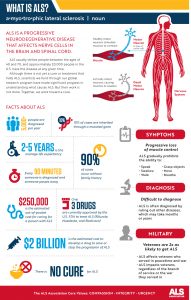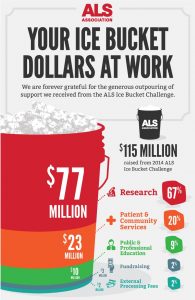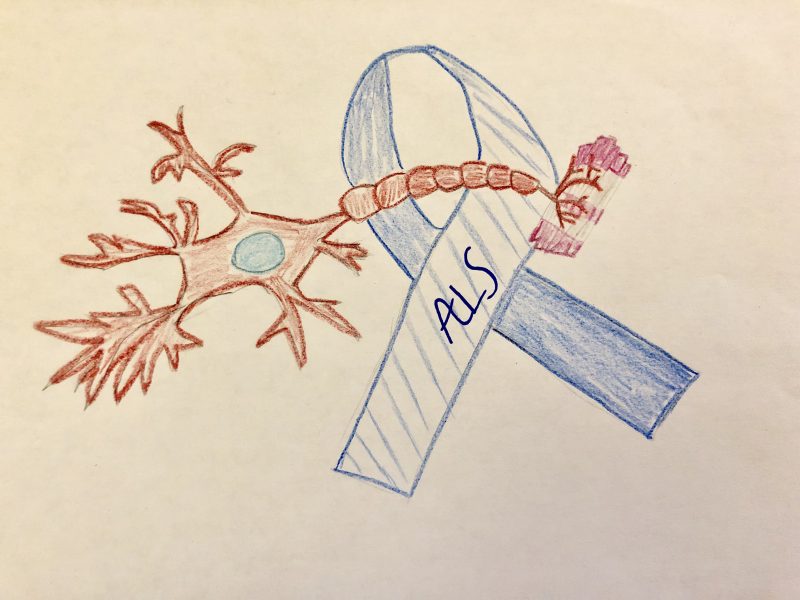In the past eight months, two celebrities, Stephen Hawking, and Stephen Hillenburg, died from ALS, or what is more commonly known as Lou Gehrig’s disease. In 2014, social media was flooded with “Ice Bucket Challenge” videos which sought to raise money for ALS research. So what is ALS, and why is the average lifespan once diagnosed 2 to 5 years?
What is ALS?
ALS, stands for amyotrophic lateral sclerosis, and is a neurodegenerative disease that affects motor neurons found in the brain and spinal cord, and causes them to  die. As the number of motor neurons decreases, the brain is no longer able to send messages to muscles, which leads to lack of muscle movement. This lack of movement causes muscle strength to weaken and muscle atrophy or muscle waste to occur. While ALS is devastating to the body, the mind of a person suffering from ALS remains sound.
die. As the number of motor neurons decreases, the brain is no longer able to send messages to muscles, which leads to lack of muscle movement. This lack of movement causes muscle strength to weaken and muscle atrophy or muscle waste to occur. While ALS is devastating to the body, the mind of a person suffering from ALS remains sound.
The Two Types of ALS
ALS can come in two different forms, familial (fALS) and sporadic (sALS). fALS accounts for 10% of total ALS diagnoses. This type of ALS stems from inheritable, autosomal genetic mutations. Familial ALS is categorized as having another family member with ALS. Sporadic ALS makes up 90% of diagnoses. Patients with sALS have no family history of the disease. The average age of onset of sALS is 56, which is roughly ten years later than fALS which is 45. While these two sub-types of ALS do not differ clinically, their main underlying differences are if the patient has family history of ALS, and the development of genetic mutations.

In both fALS and sALS, there is a mutation of the SOD1 gene or Superoxide dismutase 1. SOD1 is an antioxidant enzyme that helps defend the body against ROS or Reactant Oxygen Species that cells produce. If there is a mutation to the SOD1 gene (as seen in ALS), oxidative stress occurs. This stress can cause what is known as unfolded protein aggregation which is found in motor neurons in people with ALS.
Development of the Disease
Currently, there are two theories behind the development of ALS, and both linked by the common factors. The first theory is that oxidative stress and mitochondrial dysfunction cause changes in RNA metabolism which ultimately causes motor neuron death. The second theory states that mutations in proteins that bind RNA cause oxidative stress, which eventually leads to mitochondrial dysfunction and causes motor neuron death. The common factors in these two theories being oxidative stress, mitochondrial dysfunction, and RNA mutations ultimately lead to the degeneration of motor neurons. However, these are just two theories. No one knows for sure what trigger is for the development of ALS.
Symptoms and Onset of ALS
Now that you know some of the science surrounding ALS, lets look at the symptoms associated with ALS.
Symptoms include but are not limited to,
- Muscle weakness/loss/or atrophy
- Muscle twitches (fasciculations)/cramps/or stiffness (spasticity)
- Slurred and nasal speech
- Difficulty chewing and swallowing
- Excessive choking
- Excessive shortness of breath
- Hand or leg weakness
- Problems with balance or walking
- Fatigue
Onset of ALS typically occurs between the ages of 40 and 70, with the average age of diagnosis being 55. While the disease is more common among people age 60 and older, cases have been seen in people in their 20s and 30s. It has been shown that ALS is 20% more common in men than women, and a person’s risk percentage of developing ALS increases with age.
Once ALS starts, it continues to progress. Due to the fact there is no cure currently, most patients slowly lose the ability to walk, talk, swallow, and eventually breathe. The average survival time after diagnosis is 3 years, with 20% of those diagnosed living 5 or more years, 10% will live 10 years, and 5% will live 20 years.
What Can You Do?
Everyone has the power to help raise awareness for ALS, and there are many ways to do so. While scientists are busy working on finding a cure, we as society can rally together with events such as the Ice Bucket Challenge, and the ALS Walk to Defeat, among others.

Images:
Image 1: http://web.alsa.org/site/PageServer?pagename=WLK_BP_AboutALS#.XBAxLmhKjIU
Image 2: https://smw.ch/article/doi/smw.2015.14054/
Image 3: https://infograph.venngage.com/p/198726/ice-bucket-challenge-_new
